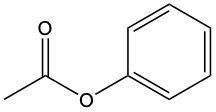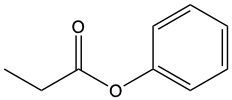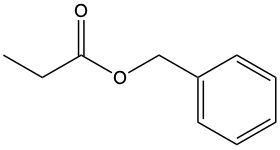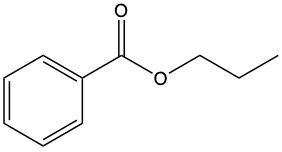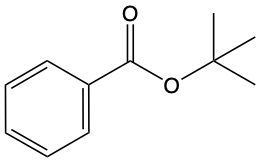Now recall esters possess an oxygen atom connected to an alkyl group, so a carbon group, and a carbon chain containing a carbonyl group. So esters have this as the portion that indicates what they are. Now, esters have a unique naming system. The carbon chain with the carbonyl group is named as though it was a carboxylic acid, but it's not a carboxylic acid anymore, it's an ester, so we have to modify the ending. So we're going to modify the ending from oic acid, which is the ending of a carboxylic acid, to oate, which is now the end of the name for an ester. In terms of our naming convention, we still talk about our substituents, and we'll see how that works in terms of esters. We'll have our parent chain where we modify the ending to oate. So keep this in mind as we start naming different types of esters.
- 1. Matter and Measurements4h 29m
- What is Chemistry?5m
- The Scientific Method9m
- Classification of Matter16m
- States of Matter8m
- Physical & Chemical Changes19m
- Chemical Properties8m
- Physical Properties5m
- Intensive vs. Extensive Properties13m
- Temperature (Simplified)9m
- Scientific Notation13m
- SI Units (Simplified)5m
- Metric Prefixes24m
- Significant Figures (Simplified)11m
- Significant Figures: Precision in Measurements7m
- Significant Figures: In Calculations19m
- Conversion Factors (Simplified)15m
- Dimensional Analysis22m
- Density12m
- Specific Gravity9m
- Density of Geometric Objects19m
- Density of Non-Geometric Objects9m
- 2. Atoms and the Periodic Table5h 23m
- The Atom (Simplified)9m
- Subatomic Particles (Simplified)12m
- Isotopes17m
- Ions (Simplified)22m
- Atomic Mass (Simplified)17m
- Atomic Mass (Conceptual)12m
- Periodic Table: Element Symbols6m
- Periodic Table: Classifications11m
- Periodic Table: Group Names8m
- Periodic Table: Representative Elements & Transition Metals7m
- Periodic Table: Elemental Forms (Simplified)6m
- Periodic Table: Phases (Simplified)8m
- Law of Definite Proportions9m
- Atomic Theory9m
- Rutherford Gold Foil Experiment9m
- Wavelength and Frequency (Simplified)5m
- Electromagnetic Spectrum (Simplified)11m
- Bohr Model (Simplified)9m
- Emission Spectrum (Simplified)3m
- Electronic Structure4m
- Electronic Structure: Shells5m
- Electronic Structure: Subshells4m
- Electronic Structure: Orbitals11m
- Electronic Structure: Electron Spin3m
- Electronic Structure: Number of Electrons4m
- The Electron Configuration (Simplified)22m
- Electron Arrangements5m
- The Electron Configuration: Condensed4m
- The Electron Configuration: Exceptions (Simplified)12m
- Ions and the Octet Rule9m
- Ions and the Octet Rule (Simplified)8m
- Valence Electrons of Elements (Simplified)5m
- Lewis Dot Symbols (Simplified)7m
- Periodic Trend: Metallic Character4m
- Periodic Trend: Atomic Radius (Simplified)7m
- 3. Ionic Compounds2h 18m
- Periodic Table: Main Group Element Charges12m
- Periodic Table: Transition Metal Charges6m
- Periodic Trend: Ionic Radius (Simplified)5m
- Periodic Trend: Ranking Ionic Radii8m
- Periodic Trend: Ionization Energy (Simplified)9m
- Periodic Trend: Electron Affinity (Simplified)8m
- Ionic Bonding6m
- Naming Monoatomic Cations6m
- Naming Monoatomic Anions5m
- Polyatomic Ions25m
- Naming Ionic Compounds11m
- Writing Formula Units of Ionic Compounds7m
- Naming Ionic Hydrates6m
- Naming Acids18m
- 4. Molecular Compounds2h 18m
- Covalent Bonds6m
- Naming Binary Molecular Compounds6m
- Molecular Models4m
- Bonding Preferences6m
- Lewis Dot Structures: Neutral Compounds (Simplified)8m
- Multiple Bonds4m
- Multiple Bonds (Simplified)6m
- Lewis Dot Structures: Multiple Bonds10m
- Lewis Dot Structures: Ions (Simplified)8m
- Lewis Dot Structures: Exceptions (Simplified)12m
- Resonance Structures (Simplified)5m
- Valence Shell Electron Pair Repulsion Theory (Simplified)4m
- Electron Geometry (Simplified)8m
- Molecular Geometry (Simplified)11m
- Bond Angles (Simplified)11m
- Dipole Moment (Simplified)15m
- Molecular Polarity (Simplified)7m
- 5. Classification & Balancing of Chemical Reactions3h 17m
- Chemical Reaction: Chemical Change5m
- Law of Conservation of Mass5m
- Balancing Chemical Equations (Simplified)13m
- Solubility Rules16m
- Molecular Equations18m
- Types of Chemical Reactions12m
- Complete Ionic Equations18m
- Calculate Oxidation Numbers15m
- Redox Reactions17m
- Spontaneous Redox Reactions8m
- Balancing Redox Reactions: Acidic Solutions17m
- Balancing Redox Reactions: Basic Solutions17m
- Balancing Redox Reactions (Simplified)13m
- Galvanic Cell (Simplified)16m
- 6. Chemical Reactions & Quantities2h 35m
- 7. Energy, Rate and Equilibrium3h 46m
- Nature of Energy6m
- First Law of Thermodynamics7m
- Endothermic & Exothermic Reactions7m
- Bond Energy14m
- Thermochemical Equations12m
- Heat Capacity19m
- Thermal Equilibrium (Simplified)8m
- Hess's Law23m
- Rate of Reaction11m
- Energy Diagrams12m
- Chemical Equilibrium7m
- The Equilibrium Constant14m
- Le Chatelier's Principle23m
- Solubility Product Constant (Ksp)17m
- Spontaneous Reaction10m
- Entropy (Simplified)9m
- Gibbs Free Energy (Simplified)18m
- 8. Gases, Liquids and Solids3h 25m
- Pressure Units6m
- Kinetic Molecular Theory14m
- The Ideal Gas Law18m
- The Ideal Gas Law Derivations13m
- The Ideal Gas Law Applications6m
- Chemistry Gas Laws16m
- Chemistry Gas Laws: Combined Gas Law12m
- Standard Temperature and Pressure14m
- Dalton's Law: Partial Pressure (Simplified)13m
- Gas Stoichiometry18m
- Intermolecular Forces (Simplified)19m
- Intermolecular Forces and Physical Properties11m
- Atomic, Ionic and Molecular Solids10m
- Heating and Cooling Curves30m
- 9. Solutions4h 10m
- Solutions6m
- Solubility and Intermolecular Forces18m
- Solutions: Mass Percent6m
- Percent Concentrations10m
- Molarity18m
- Osmolarity15m
- Parts per Million (ppm)13m
- Solubility: Temperature Effect8m
- Intro to Henry's Law4m
- Henry's Law Calculations12m
- Dilutions12m
- Solution Stoichiometry14m
- Electrolytes (Simplified)13m
- Equivalents11m
- Molality15m
- The Colligative Properties15m
- Boiling Point Elevation16m
- Freezing Point Depression9m
- Osmosis16m
- Osmotic Pressure9m
- 10. Acids and Bases3h 29m
- Acid-Base Introduction11m
- Arrhenius Acid and Base6m
- Bronsted Lowry Acid and Base18m
- Acid and Base Strength17m
- Ka and Kb12m
- The pH Scale19m
- Auto-Ionization9m
- pH of Strong Acids and Bases9m
- Acid-Base Equivalents14m
- Acid-Base Reactions7m
- Gas Evolution Equations (Simplified)6m
- Ionic Salts (Simplified)23m
- Buffers25m
- Henderson-Hasselbalch Equation16m
- Strong Acid Strong Base Titrations (Simplified)10m
- 11. Nuclear Chemistry56m
- BONUS: Lab Techniques and Procedures1h 38m
- BONUS: Mathematical Operations and Functions47m
- 12. Introduction to Organic Chemistry1h 34m
- 13. Alkenes, Alkynes, and Aromatic Compounds2h 12m
- 14. Compounds with Oxygen or Sulfur1h 6m
- 15. Aldehydes and Ketones1h 1m
- 16. Carboxylic Acids and Their Derivatives1h 11m
- 17. Amines38m
- 18. Amino Acids and Proteins1h 51m
- 19. Enzymes1h 37m
- 20. Carbohydrates1h 46m
- Intro to Carbohydrates4m
- Classification of Carbohydrates4m
- Fischer Projections4m
- Enantiomers vs Diastereomers8m
- D vs L Enantiomers8m
- Cyclic Hemiacetals8m
- Intro to Haworth Projections4m
- Cyclic Structures of Monosaccharides11m
- Mutarotation4m
- Reduction of Monosaccharides10m
- Oxidation of Monosaccharides7m
- Glycosidic Linkage14m
- Disaccharides7m
- Polysaccharides7m
- 21. The Generation of Biochemical Energy2h 8m
- 22. Carbohydrate Metabolism2h 22m
- 23. Lipids2h 26m
- Intro to Lipids6m
- Fatty Acids25m
- Physical Properties of Fatty Acids6m
- Waxes4m
- Triacylglycerols12m
- Triacylglycerol Reactions: Hydrogenation8m
- Triacylglycerol Reactions: Hydrolysis13m
- Triacylglycerol Reactions: Oxidation7m
- Glycerophospholipids15m
- Sphingomyelins13m
- Steroids15m
- Cell Membranes7m
- Membrane Transport10m
- 24. Lipid Metabolism1h 45m
- 25. Protein and Amino Acid Metabolism1h 37m
- 26. Nucleic Acids and Protein Synthesis2h 54m
- Intro to Nucleic Acids4m
- Nitrogenous Bases16m
- Nucleoside and Nucleotide Formation9m
- Naming Nucleosides and Nucleotides13m
- Phosphodiester Bond Formation7m
- Primary Structure of Nucleic Acids11m
- Base Pairing10m
- DNA Double Helix6m
- Intro to DNA Replication20m
- Steps of DNA Replication11m
- Types of RNA10m
- Overview of Protein Synthesis4m
- Transcription: mRNA Synthesis9m
- Processing of pre-mRNA5m
- The Genetic Code6m
- Introduction to Translation7m
- Translation: Protein Synthesis18m
Naming Esters - Online Tutor, Practice Problems & Exam Prep
 Created using AI
Created using AIEsters are organic compounds characterized by an alkyl group connected to an oxygen atom and a carbon chain with a carbonyl group. Their naming involves modifying the carboxylic acid suffix "oic acid" to "ate." Common naming follows a similar pattern, starting with the alkyl group followed by the carbon chain name, ending in "ate." For example, a propyl group attached to a valerate results in "propyl valerate." When multiple substituents are present, they are named in alphabetical order, with prefixes indicating quantity, such as di- for two or tri- for three.
IUPAC Rules for Naming Esters Concept 1
Video transcript
IUPAC Rules for Naming Esters Example 1
Video transcript
Provide the systematic name for the following ester. To do that, we're going to utilize the following steps:
- We have to identify the alkyl group connected to the oxygen atom, and we're going to name the alkyl group as a substituent. Now, when it comes to this alkyl group connected to our oxygen, no numerical location for the alkyl group is needed. So if we take a look here, I've highlighted the portion that's the alkyl group. So here it's a 2-carbon alkyl group, which is ethyl.
- We identify the carbonyl chain connected to the carbonyl group. The carbonyl group is highlighted in yellow here.
- Figure out the length of the carbon chain starting from the carbonyl group. Here I've already numbered it for us, so we start here, 1, 2, 3, 4. The carbonyl group is Carbon number, as Carbon number 1 is implied.
- Now, here we have to assign numbers for the location of each substituent on the carbon chain with the carbonyl group. Here we have, as our substituent, this methyl group down here. When there is more than one identical substituent, we use the prefixes of 'di' for 2, 'tri' for 3, and 'tetra' for 4. So here, we have a methyl group. And remember, this is our original one, the alkyl group which is ethyl.
- We name all substituents in alphabetical order, prefixes do not count. And here, we're going to use commas to separate numbers from numbers, and we're going to use dashes to separate letters from numbers. We do not separate letters from letters, and this is important.
- Here, an additional step we have to take into mind is where we write the alkyl group name with spaces.
So, let's put all this together. Since 'e' comes before 'm', it's going to be ethyl. Remember this, we write it with spaces. Then we're going to have what? On carbon number 3 of the carbon chain, we're going to have a methyl so 3-methyl. And then here it's a 4-carbon chain, which is butane, and as a carboxylic acid, it would have been butanoic acid. But remember, we're changing this to 'ate'. So it becomes butanoate. Therefore, it would be ethyl 3-methyl butanoate, and that would be the name of this particular ester.
Provide the systematic name for the following ester.
propyl butanoate
butyl propanoate
isopropyl butanoate
isobutyl propanoate
Provide the systematic name for the following ester.
tert-butyl 3,3-dimethylpentanoate
sec-butyl 3,3-dimethylpentanoate
tert-butyl 4,4-dimethylpentanoate
isopropyl 3,3-dimethylpentanoate
If the substituent name of benzene is phenyl, which structure represents phenyl propanoate?
Common Naming: Esters Concept 2
Video transcript
When it comes to the common naming of esters, we're going to follow the same rules as IUPAC, except now the parent chain consists of common name prefixes with an -ate ending. So the naming convention will be substituent, prefix, and then modifier. Let's take a look at this example. It asks us to provide a common name for the following ester:
- Identify the alkyl group connected to the oxygen atom. Looking at the structure, the alkyl group is a 3-carbon chain named propyl, which we name as a substituent. Remember, substituents are named at the beginning of the name. Here, no numerical location for the alkyl group is needed because it is attached directly to an oxygen, not a carbon.
- Identify and name the carbon chain including the carbonyl group. We figure out the length of the carbon chain starting from the carbonyl group, which as carbon number 1 is implied. In this case, there are 5 carbons. For common names, a 5-carbon chain uses the prefix valer-, and since it is an ester, we use the ending -ate, resulting in valerate.
- Assign numbers to the locations of each substituent on the carbon chain with the carbonyl group. When more than one identical substituent is attached, use prefixes such as di- for 2, tri- for 3, and tetra- for 4. Name all substituents in alphabetical order, noting that prefixes do not count.
Now, valerate is the name of the carbon chain including the carbonyl group. Attached to carbon number 2, there is an isopropyl group. Thus, this substituent makes it '2-isopropyl valerate'.
Finally, commas are used to separate numbers from numbers, and dashes are used to separate letters from numbers. Letters are not separated from letters. Remember to write the alkyl group name with spaces.
So, bringing it all together, the alkyl group attached to the oxygen was propyl, placed at the beginning of the name. The complete name of the ester is 'propyl 2-isopropyl valerate'. This indicates that this propyl portion is connected to the oxygen of the ester, and the rest, highlighted in red, is part of the main chain that contains a carbonyl group. This is the approach we take when naming esters using a common naming system.
Provide common name for given compound.
cyclopentyl-4,4-dimethyl valerate
cyclopentyl 4,4,4-trimethyl butyrate
cyclopentyl 4,4-dimethyl valerate
cyclopentyl-4,4,4-trimethyl butyrate
Give a common name for the following compound.
tert-butyl benzoic acid
butyl benzoate
tert-butyl benzoate
sec-butyl benzoate
Draw structure for given name: hexyl 3-chlorobutyrate.
Do you want more practice?
Here’s what students ask on this topic:
What is the general structure of an ester?
An ester is an organic compound characterized by an alkyl group connected to an oxygen atom, which is also bonded to a carbon chain containing a carbonyl group. The general structure can be represented as RCOOR', where R and R' are alkyl or aryl groups. The carbonyl group (C=O) is bonded to the oxygen atom, which in turn is bonded to another carbon chain or alkyl group. This unique structure gives esters their distinctive properties and naming conventions.
 Created using AI
Created using AIHow do you name esters using the IUPAC system?
In the IUPAC system, esters are named by modifying the name of the corresponding carboxylic acid. The suffix 'oic acid' of the carboxylic acid is changed to 'ate.' The alkyl group attached to the oxygen atom is named first, followed by the modified name of the acid. For example, if the ester is derived from acetic acid and has a methyl group attached to the oxygen, it is named methyl acetate. The general format is: [Alkyl group] [acid name with 'ate' ending].
 Created using AI
Created using AIWhat are the steps to name an ester using common names?
To name an ester using common names, follow these steps: 1) Identify the alkyl group attached to the oxygen atom and name it. 2) Identify the carbon chain with the carbonyl group and name it using common name prefixes, ending with 'ate.' 3) Combine the names, starting with the alkyl group followed by the carbon chain name. For example, for an ester with a propyl group attached to a valerate chain, the name would be propyl valerate. If there are multiple substituents, list them in alphabetical order with appropriate prefixes (di-, tri-, etc.).
 Created using AI
Created using AIHow do you handle multiple substituents when naming esters?
When naming esters with multiple substituents, follow these steps: 1) Identify and name each substituent. 2) Assign a number to each substituent based on its position on the carbon chain, starting from the carbonyl carbon as position 1. 3) Use prefixes like di-, tri-, and tetra- to indicate the number of identical substituents. 4) List the substituents in alphabetical order, ignoring the prefixes when alphabetizing. For example, if an ester has two methyl groups on the second carbon of a butanoate chain, it would be named dimethyl butanoate.
 Created using AI
Created using AIWhy don't we need to specify the location of the alkyl group attached to the oxygen in esters?
In esters, the alkyl group attached to the oxygen atom does not require a numerical location because it is always directly bonded to the oxygen. Unlike other functional groups that can attach to different positions on a carbon chain, the alkyl group in esters has a fixed position. Therefore, specifying its location is unnecessary, simplifying the naming process. For example, in ethyl acetate, 'ethyl' is understood to be attached to the oxygen without needing further clarification.
 Created using AI
Created using AIYour GOB Chemistry tutor
- Write the formulas of potassium salicylate and disodium oxalate (refer to Table 17.1).
- Give systematic names for the following structures and structures for the names:d. Phenyl-o-hydroxybenzoate
- What is the ester responsible for the flavor and odor of the following fruit?c. apricot
- What is the ester responsible for the flavor and odor of the following fruit?c. apricot
- The ester methyl butanoate has the odor and flavor of strawberries. (14.3, 14.4)a. Draw the condensed structu...
- Write the IUPAC and common names, if any, for each of the following: (14.1, 14.3) ...
- Write the IUPAC and common names, if any, for each of the following: (14.1, 14.3) ...
- Draw the condensed structural formulas for a and b and line-angle formulas for c and d:a. pentyl formate
- Propyl acetate is the ester that gives the odor and smell of pears. (9.4, 10.6, 14.3, 14.4) ...
- Write the IUPAC and common names, if any, for each of the following:a. <IMAGE>
- Draw the condensed structural formulas for a and b and line-angle formulas for c and d:b. butyl formate
- Draw the condensed structural formulas for a and b and line-angle formulas for c and d:d. methyl propanoate
- Draw the condensed structural formulas for a and b and line-angle formulas for c and d:c. propyl benzoate
- Write the IUPAC and common names, if any, for each of the following: (14.1, 14.3)c. <IMAGE>


